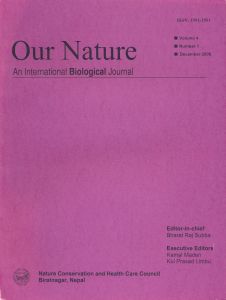Diet Analysis of Gaur (<i>Bos gaurus gaurus</i> Smith, 1827) by Micro-Histological Analysis of Fecal Samples in Parsa Wildlife Reserve, Nepal
DOI:
https://doi.org/10.3126/on.v4i1.499Keywords:
Bos gaurus gaurus, Food habits, Micro-histological analysisAbstract
The uses of food plants by gaur Bos gaurus gaurus were studied by micro-histological analysis of fecal samples in Parsa Wildlife Reserve, Nepal with an aim to explore the diet composition, preferable food plants and monthly variation in plants consumption. The results have shown that the diet of gaur consisted of diverse species of plants (49 species). On an average, grass comprises a major proportion (66%), followed by browse (25%) and herb and others (5%). Although gaur consumes variety of food plants, six plant species: four grass- Themada sp., Phragmites karka, Imperata cylindrica and Vetiveria zizanoides and two browse – Wendlandia exserta and Phaulopsis imbricata are highly preferred. The highest browse to grass ratio (1.27) was estimated during January and least (0.7) during June.
Keywords: Bos gaurus gaurus, Food habits, Micro-histological analysis
doi:10.3126/on.v4i1.499
Our Nature Vol.4(1) 2006 pp20-28
Downloads
1087
1062




